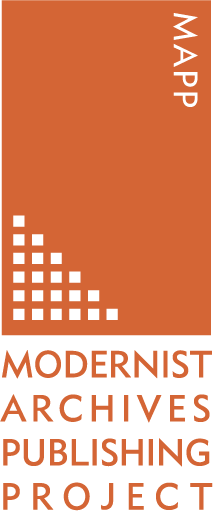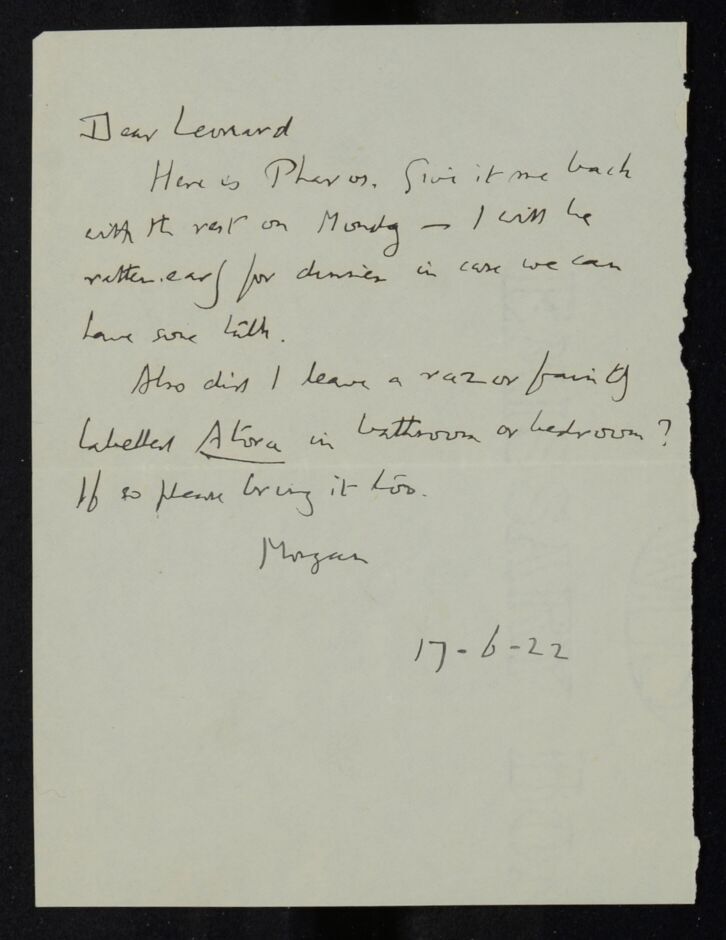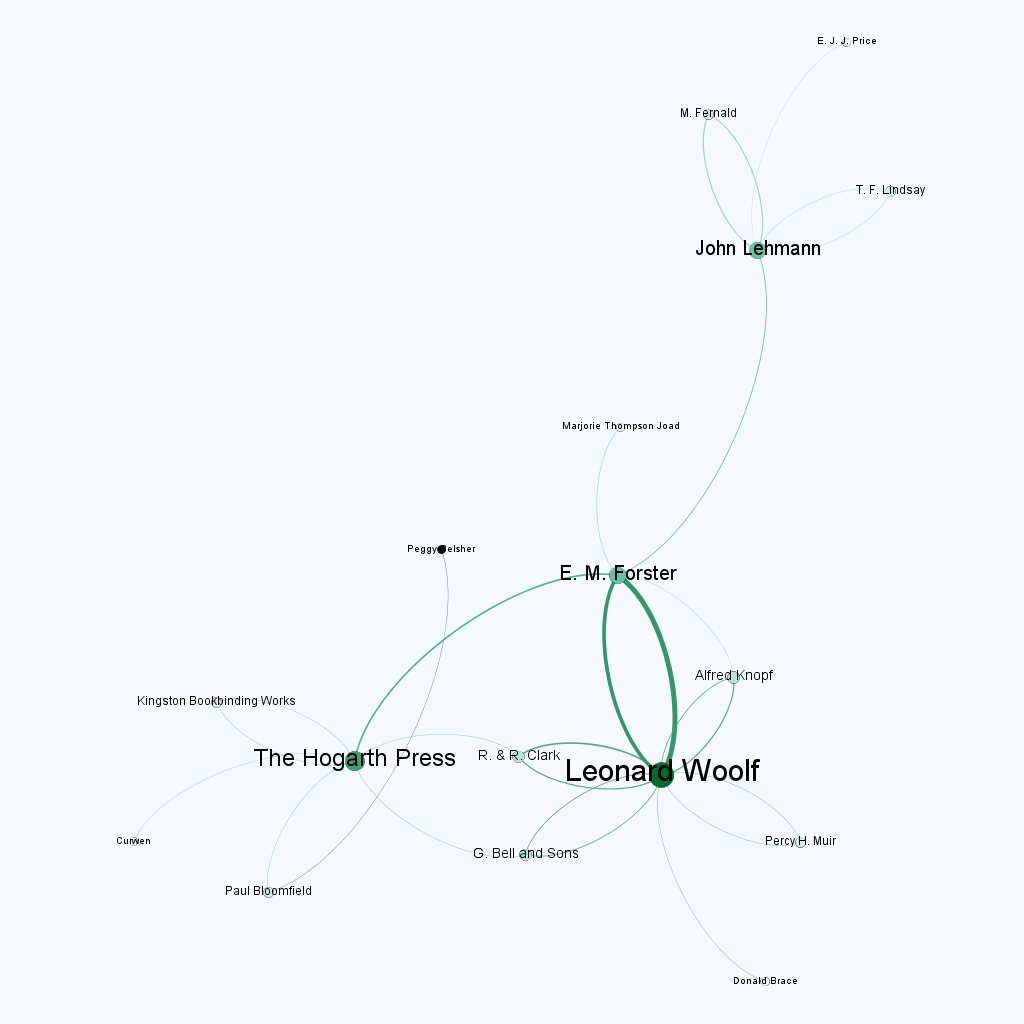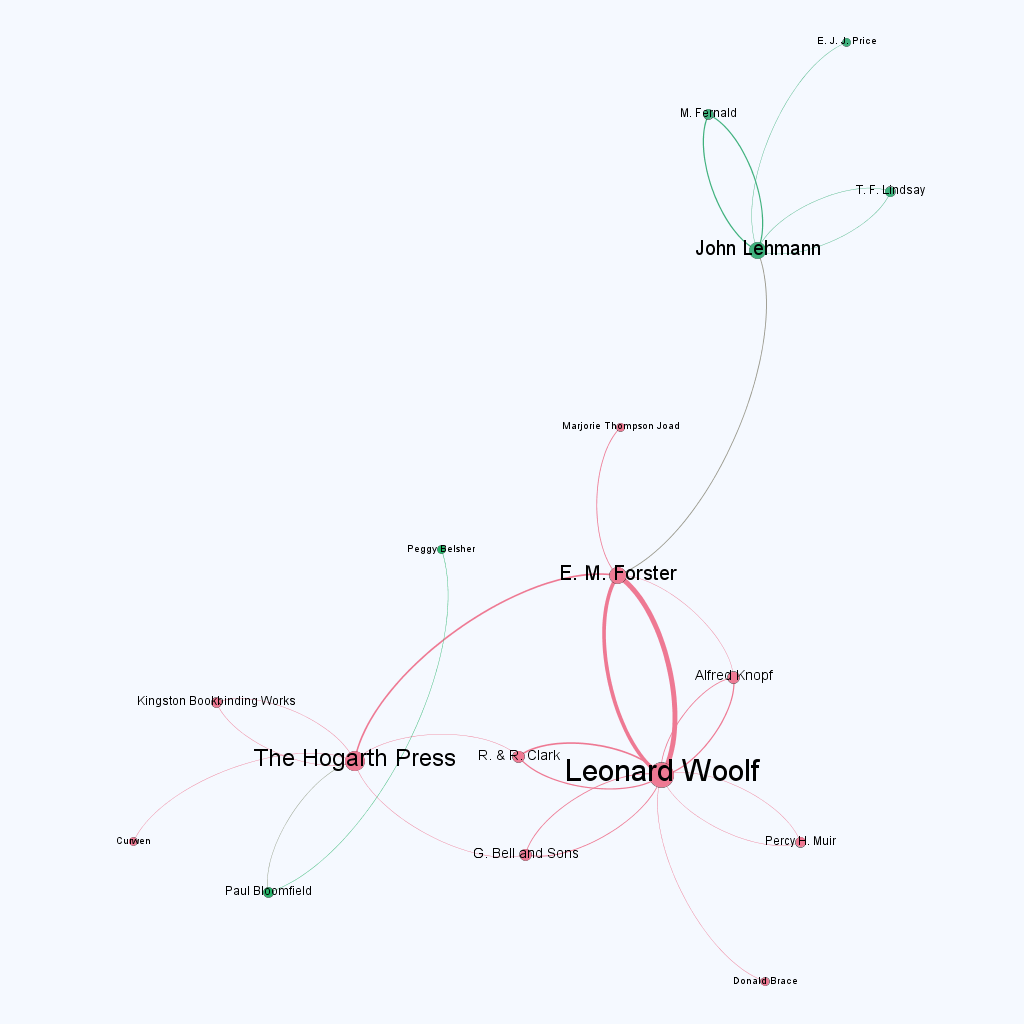Beginning in that annus mirabilis of modern literature, 1922, and petering out in 1950, the letters between novelist E. M. Forster and the Hogarth Press provide a fascinating and extended glimpse of the relationship between one of England’s best novelists and his publishing agents. This trove of letters features discussions about the technical particulars of paper color and type, of distribution and copyright, but they also hint at personal details of the correspondents, most notably between Leonard Woolf and Forster, or “Morgan” as he’s addressed. Although most of the letters sent during this 28-year period focus on publishing and distribution, small details about the relationship between the two men peek through the negotiations and discussions about Forster’s book Pharos and Pharillon, published by Hogarth Press in May 1923. Both aspects of this collection are fascinating for scholars and students of modern publishing and literature.
Image courtesy of: UoR_MS 2750_93, Hogarth Press Archive (University of Reading) MS 2750_93. Permission has been granted by The Provost and Scholars of King’s College, Cambridge and The Society of Authors as the E.M. Forster Estate. The image is also available on the MAPP page for Forster (date June 17, 1922).
Unlike Forster’s novels, Pharos and Pharillon is a nonfiction account of Alexandria, Egypt from antiquity to the present. Forster had registered as a conscientious objector during the First World War and was sent to Alexandria with the Red Cross, after which he published Alexandria: A History and a Guide recounting his war experiences. As J. H. Willis notes, Pharos and Pharillon comes out of much of this previous writing but traces a much longer history of place.[1] “Such is the scene where the following actions and meditations take place” Forster introduces the book, “that limestone ridge, with alluvial country on one side of it and harbours on the other . . . Here Africans, Greeks, and Jews combined to make a city . . . here after secular decay rose another city, still visible, where I worked or appeared to work during a recent war.”[2] The first half of the book, Pharos, represents the ancient history of the city, the invasions and occupations by Greeks and Jews and the establishment of the lighthouse at Pharos. The second half of the book transports readers to modern Alexandria, beginning with the arrival of travel writer Eliza Fay in 1779, whose letter Forster edited, and ending with analysis of the poetry of Alexandrian C. P. Cavafy.
Reading the letters between Forster and Leonard reveals significant details about the publication of this slim volume. In his letter dated June 30, 1922, Leonard asks Forster if he can cut “Royalty,” one of the chapters in Pharos and Pharillon, to make the book easier to print. Leonard also suggests that he initially print about 900 copies and questions who will be doing the outreach for Pharos and Pharillon to America, suggesting he could handle it for a 10% agent commission.[3] This shows Leonard’s business acumen and range of services as he offers more than printing and typesetting to his clients, and Forster accepts his offer to reach out to the Americans. Many of the subsequent letters in this collection are from Leonard to various American publishers such as Harcourt Brace, G. P. Putnam’s American branch (those “incorrigible nibblers” as Leonard calls them in his March 17th, 1923 letter[4]) and Knopf. Harcourt Brace declines to publish Pharos and Pharillon, claiming that it is “a delightful little book, but it is I fear too slight and remote to get much attention here.”[5] Knopf is even more direct, although they do decide to publish it: “I should certainly not be willing to consider paying an advance on such a book.”[6] Eventually, however, as Leonard brags to Forster, Knopf changes tack and agrees to advance the book: “I have screwed an advance of £20 out of Knopf without much difficulty.”[7]
Equally interesting as details about Woolf’s negotiations with other publishers are his discussions with printers and bookbinders about producing the physical object of the book itself. One of the most fascinating aspects of a project like MAPP is tracing the decisions and discussions that go into the creation of a book. Leonard writes to Scottish printers R & R Clark in June, 1923 to secure an estimate for printing Pharos and Pharillon. “I enclose a copy of the above book which we printed ourselves and published a week or so ago,” Woolf begins. “It has sold so well that we have already exhausted our edition and I am most anxious if possible to bring out a cheaper edition immediately.” Woolf then requests an estimate for printing 1000 copies set in “Garamond type” “on paper similar to that used in Talks with Tolstoi.”[8] Such exchanges show the relationships established between the Woolfs and others in the bookbinding and printing realm (which I plan to demonstrate in future network analyses of these letters). Woolf uses insider references to other books printed by Clark, where Talks with Tolstoi becomes a measuring stick for other projects. But, this relationship may be partly one-sided. In response to Woolf’s intertextual referent for printing, R & R Clark requests clarity on style, suggesting Pica Garamond. Forster writes to Leonard regarding this plan for a cheaper edition: “Please arrange it at once if you can and as for ‘terms’. I leave it to you to give me what is right; or possibly this edition comes under our existing understanding?”[9]
But the printing of a cheaper edition would not occur completely without obstacles. In a later letter, it is clear that Forster objects to the proofs. Woolf writes regarding the paper selection, “I have tried to countermand the nectarine paper for a blue, but the colour question in these kinds of papers is desperate.”[10] In the same letter, it is also clear that there may have been a dispute over the royalties percentage for the edition: “As to the question of profits,” Woolf continues. “I dont [sic] want you to think us grasping, but the point is this. The net profits are the total receipts from sales minus the total expenditure . . . But if you think the system not fair to the author, we will certainly alter the terms.” Forster responds with contrition, “I hasten to withdraw, with all the expressions of honour customary on the occasion, my letter,” claiming he had forgotten the original terms.[11] Such exchanges demonstrate the intimacy, and potential peril, attendant on publishing books written by friends and colleagues.
The letters between Forster and Leonard also reveal tidbits about their personal relationship. Some of the letters conclude with a personal note, providing a glimpse into the particular moment in which they were written. What beyond the task at hand was on the minds of these authors? What quotidian concerns interrupted the business of writing and publishing? In a letter full of details about the contract for Pharos and Pharillon, Forster concludes by asking Leonard if he knows a “sensible oculist”: “I have had a little trouble with my eyes. They have always been good so far, so I am anxious to avoid the costly and pretentious expert.”[12] There are mentions of a trip to the zoo with Virginia in a letter about proofs, and Forster inquires about a lost razor “faintly labelled Atora” which he had left in “bathroom or bedroom.”[13] There is also a cryptic reference to coping with an “enclosed goose” to which Leonard replies: “We have dealt with the hen partridge or goose.”[14]
Beyond the details we discover through reading these letters, which you can now access on MAPP’s archive, we can also access the big picture of the E. M. Forster correspondence with Leonard Woolf and the Hogarth Press. What are the prevailing motifs and communities represented in the nearly 30 years of correspondence? Part of my work with MAPP has been to construct publishing networks out of the letters, with senders and receivers of letters represented as nodes connected by lines of communication. Such a project reveals the clusters of activity that undergird the production of cultural objects through printing and publishing. Networks help us visualize the social practices that produce such cultural objects but which are often obscured over time. By accessing the ephemera in the archive, and making it digitally available, we unearth those social practices and make them visible again.
This visualization of Forster’s network captures the entirety of his correspondence regarding Pharos and Pharillon. Larger hubs represent nodes with the most connections to other nodes, and larger lines, or edges, represent multiple exchanges between nodes. The larger the node, the more connections. The larger the edge, the more exchanges. We can see from a glance at Forster’s network that there are four major nodes in this network: E. M. Forster, Leonard Woolf, John Lehmann, and the Hogarth Press, this last category representing letters that were unsigned and thus impossible to track definitively to one staff member (although we do get one letter signed by Peggy Belsher, secretary). The importance of these nodes is clear, as they are the actors involved in negotiating and producing the book. But there are also smaller nodes that seem important based on their higher-than-normal degree: G. Bell and Sons, Kingston Bookbinding Works, and Alfred Knopf. These nodes are important since they are the agencies involved in negotiating and printing the extra copies required once the book starts to sell. In other words, these are nodes who displayed interest in the book. Alfred Knopf, as I mentioned earlier, agrees to publish the American edition, so he is an important figure in this correspondence. Also, note that all the edges to these other actors emanate from either Leonard or the Hogarth Press, with the strongest line of communication between Woolf and Forster. If you sign with Hogarth, Leonard and his staff do a lot of work to ensure enough copies are printed and that they are distributed internationally.
We can also discern communities based on frequency of connections within clusters of nodes. If we group the nodes based on the communities in which they are associated, and we change the colors of the nodes and edges to represent this interconnectivity within discrete communities, we can organize the larger network into smaller assemblages. Because of the smallness of the Forster network, we see two communities. Most of the nodes (pink, 75%) are clustered around Leonard and Forster, representing the early flurry of activity to get the book printed and distributed. The smaller community (green, 25%) are clustered around John Lehmann, who joined as the press manager in 1931. As we can see, these letters are exchanged with an “M. Fernald”, E. J. J. Price, and T. F. Lindsay. This cluster represents a series of letters between the Hogarth Press and the British Council beginning in 1943 regarding some copyright infringements of Pharos and Pharillon. Lehmann had discovered selections of the book published in the British Council’s Cairo journal Citadel. This smattering of letters demonstrates the extended relationships that publishing books entails. Nearly 20 years after publication, the Hogarth Press protects their authors, and the exchange is fascinating for the increasing stridency as Citadel publishes another selection without permission.
As MAPP adds more materials related to the Hogarth Press and beyond, the larger picture of twentieth-century publishing in England and the U.S. will become ever more visible and the networks will vastly expand. The Forster materials alone reveal illuminating specifics about the work done by the Hogarth Press to publish, print, and distribute one book. Have a look at the materials we’ve added so far and follow MAPP to explore more ephemera as we continue to curate it.
[1] Leonard and Virginia Woolf as Publishers: The Hogarth Press 1917-41. U of Virginia P, 1992. 67.
[2] Forster, E. M. Pharos and Pharillon. Alfred Knopf, 1962. 12.
[3] Leonard Woolf to E. M. Forster, June 30, 1922. Archives of the Hogarth Press, MS 2750/93, University of Reading, United Kingdom. All citations from same source.
[4] Leonard Woolf to E. M. Forster, March 17, 1923.
[5] Donald Brace to Leonard Woolf, March 12, 1923.
[6] Alfred Knopf to Leonard Woolf, March 21, 1923.
[7] Leonard Woolf to E. M. Forster, March 23, 1923.
[8] Leonard Woolf to R & R Clark, June, 1923.
[9] Original emphasis, E. M. Forster to Leonard Woolf, June 19, 1923.
[10] Leonard Woolf to E. M. Forster, July 1, 1923.
[11]E. M. Forster to Leonard Woolf, July 2, 1923.
[12]E. M. Forster to Leonard Woolf, June 8, 1923.
[13]E. M. Forster to Leonard Woolf, June 17, 1923.
[14] E. M. Forster to Leonard Woolf, Feb. 20, 1926. Leonard Woolf to E. M. Forster, Feb. 23, 1926.






